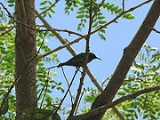
Beautiful Sunbird
Encyclopedia
The Beautiful Sunbird, Cinnyris pulchella (formerly placed in the genus
Nectarinia), is a sunbird
. The sunbirds are a group of very small Old World
passerine
bird
s which feed largely on nectar, although they will also take insects, especially when feeding young. Flight is fast and direct on their short wings. Most species can take nectar by hovering like a hummingbird, but usually perch to feed most of the time.
The Beautiful Sunbird is a common breeder across sub-Sahara
n tropical Africa
. One or two egg
s are laid in a suspended nest in a tree. It is a seasonal migrant
within its range.
Beautiful Sunbirds are tiny, only 10 cm long, although the breeding male's long tail adds another 5 cm. They have medium-length thin down-curved bills and brush-tipped tubular tongues, both adaptations to their nectar feeding.
The adult male is mainly glossy green with a yellow and crimson breast band. He has long tail streamers. The female is greenish-brown above and yellowish below.
This species is found in a variety of open habitats with some trees, including savannah and hotel gardens.
Genus
In biology, a genus is a low-level taxonomic rank used in the biological classification of living and fossil organisms, which is an example of definition by genus and differentia...
Nectarinia), is a sunbird
Sunbird
The sunbirds and spiderhunters are a family, Nectariniidae, of very small passerine birds. There are 132 species in 15 genera. The family is distributed throughout Africa, southern Asia and just reaches northern Australia. Most sunbirds feed largely on nectar, but also take insects and spiders,...
. The sunbirds are a group of very small Old World
Old World
The Old World consists of those parts of the world known to classical antiquity and the European Middle Ages. It is used in the context of, and contrast with, the "New World" ....
passerine
Passerine
A passerine is a bird of the order Passeriformes, which includes more than half of all bird species. Sometimes known as perching birds or, less accurately, as songbirds, the passerines form one of the most diverse terrestrial vertebrate orders: with over 5,000 identified species, it has roughly...
bird
Bird
Birds are feathered, winged, bipedal, endothermic , egg-laying, vertebrate animals. Around 10,000 living species and 188 families makes them the most speciose class of tetrapod vertebrates. They inhabit ecosystems across the globe, from the Arctic to the Antarctic. Extant birds range in size from...
s which feed largely on nectar, although they will also take insects, especially when feeding young. Flight is fast and direct on their short wings. Most species can take nectar by hovering like a hummingbird, but usually perch to feed most of the time.
The Beautiful Sunbird is a common breeder across sub-Sahara
Sahara
The Sahara is the world's second largest desert, after Antarctica. At over , it covers most of Northern Africa, making it almost as large as Europe or the United States. The Sahara stretches from the Red Sea, including parts of the Mediterranean coasts, to the outskirts of the Atlantic Ocean...
n tropical Africa
Africa
Africa is the world's second largest and second most populous continent, after Asia. At about 30.2 million km² including adjacent islands, it covers 6% of the Earth's total surface area and 20.4% of the total land area...
. One or two egg
Egg (biology)
An egg is an organic vessel in which an embryo first begins to develop. In most birds, reptiles, insects, molluscs, fish, and monotremes, an egg is the zygote, resulting from fertilization of the ovum, which is expelled from the body and permitted to develop outside the body until the developing...
s are laid in a suspended nest in a tree. It is a seasonal migrant
Bird migration
Bird migration is the regular seasonal journey undertaken by many species of birds. Bird movements include those made in response to changes in food availability, habitat or weather. Sometimes, journeys are not termed "true migration" because they are irregular or in only one direction...
within its range.
Beautiful Sunbirds are tiny, only 10 cm long, although the breeding male's long tail adds another 5 cm. They have medium-length thin down-curved bills and brush-tipped tubular tongues, both adaptations to their nectar feeding.
The adult male is mainly glossy green with a yellow and crimson breast band. He has long tail streamers. The female is greenish-brown above and yellowish below.
This species is found in a variety of open habitats with some trees, including savannah and hotel gardens.

